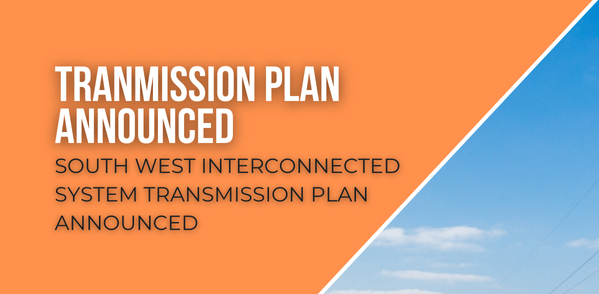South West Interconnected System Transmission Plan Announced – Summary
Purpose and Context
The Plan lays out the Government of Western Australia’s long-term strategy for upgrading and expanding transmission infrastructure in the SWIS (South West Interconnected System) to support the transition from coal towards clean, renewable energy.
Major drivers are: retiring all state-owned coal generation by 2030, increasing renewable penetration, meeting rising demand (industrial, residential), ensuring reliability and system security.
Key Statistics and Trends
In 2024-25, ~39% of electricity used on the SWIS came from renewable sources, about triple what it was in 2016.
At one point in late 2024, renewables supplied ~85.1% of SWIS generation.
Grid-scale battery storage in SWIS is growing: nearly 1.5 GW by end of 2025.
Rooftop solar has exploded: ~41% of homes in the SWIS footprint have rooftop solar; target is ~50% by 2030.
Peak demand is also rising: record ~4,484 MW on 20 Jan 2025; forecast for 2025-26 is ~4,734 MW.
Infrastructure Plan (Clean Energy Link Program) Phases
The Plan is divided into three phases of investment and transmission build-out:
| Phase | Timeframe | Focus / Major Projects | Capacity / Outcomes |
|---|---|---|---|
| Phase One | 2025-2030 | Enable coal retirement, meet growing industrial demand, connect new renewable generation. Major projects include: Clean Energy Link – North, Stage One of CEL-East, CEL-Kwinana Strengthening, and augmentation around Collie (Coolangatta Industrial Estate), Kemerton SIA. | E.g., CEL-East Stage One connects ~1.6 GW new renewable capacity in east region; CEL-Kwinana will enable ~900 MW new industrial load; Coolangatta Industrial Estate ~500 MW. |
| Phase Two | 2030-2035 | Support larger scale industrial load growth, household demand increases, further renewable and storage capacity. Projects are to be triggered by demand forecasts. Some projects identified: Moora, Chittering, further expansion of CEL-East stages. | |
| Phase Three | 2035 and beyond | Powering green export industries (hydrogen, ammonia), heavy electrification, enabling large new renewable projects, possibly beyond current network footprint. Still many uncertainties. |
Strategic Policy Considerations
The Plan aligns with broader WA policies: Made in WA, Diversify WA and the activation of Strategic Industrial Areas (SIAs). Its transmission build is meant to enable industrial growth, local manufacturing (including transmission components), and job creation.
Public ownership: SWIS transmission is publicly owned (Western Power), which is seen as enabling transmission investment to be used as an economic lever.
Just transition for Collie (a coal region): significant focus on diversifying the economy there, with plans in the Collie / Coolangatta area to unlock industrial capacity, infrastructure, and jobs as coal is retired.
Challenges and Risks
The speed of coal retirement means tight timelines for new generation, storage, and transmission to be ready by 2030.
The complexity of planning, approvals, land access, environmental studies is recognized and could delay delivery.
The need to balance cost: avoiding over-investment (which burdens users/taxpayers) while ensuring enough capacity for reliability and growth.
Uncertainty in future demand (industrial load, green export sectors, etc.) makes planning tricky for Phase Two & Three.
Implementation Commitments
Over AUD $1.6 billion already invested in transmission expansion/enhancement; in the 2025-26 State Budget $584 million is allocated.
Clean Energy Link – North already under construction; expected in service by December 2027.
Regulatory steps: certain projects given “priority project” status to streamline approvals; frameworks (e.g. Critical Projects Framework) in place to manage connections and queueing.
Read the full announcement here

